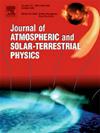2022年10月25日日偏食期间VLF信号的研究
IF 1.8
4区 地球科学
Q3 GEOCHEMISTRY & GEOPHYSICS
Journal of Atmospheric and Solar-Terrestrial Physics
Pub Date : 2025-02-05
DOI:10.1016/j.jastp.2025.106458
引用次数: 0
摘要
2022 年 10 月 25 日的日偏食对 GQD(22.10 kHz)和 DHO(23.40 kHz)传输路径上的甚低频(VLF)信号有明显影响。分析了 2022 年 10 月 22 日至 28 日的信号变化,重点是日偏食(GE)阶段的振幅变化。日偏食期间,GQD 和 DHO 信号路径分别受到 11% 和 14% 的阻挡。日食当天,GQD 的振幅比日食前低 0.83 分贝,比日食后高 0.11 分贝;日食前后,DHO 的振幅比日食前高 0.26 分贝,比日食后高 0.57 分贝。观测结果表明,与 DHO 信号相比,GQD 信号中的太阳耀斑特征更强,这归因于传播路径沿线电离层条件的差异。在 GE 阶段前后,GQD 信号的振幅明显上升,这与太阳耀斑活动有关。此外,分析还证实,在 GE 阶段,PSE 是沿 DHO 路径的甚低频信号振幅增大的主要驱动因素。这些结果强调了日偏食对电离层动态和甚低频信号传播的重大影响。本文章由计算机程序翻译,如有差异,请以英文原文为准。
Study of VLF signal during partial solar eclipse of 25 October 2022
The partial solar eclipse on October 25, 2022, had an observable effect on very low frequency (VLF) signals along the transmission paths of GQD (22.10 kHz) and DHO (23.40 kHz). Signal variations were analyzed for October 22–28, 2022, with a focus on amplitude changes during the greatest eclipse (GE) phase. During the partial solar eclipse, the GQD and DHO signal paths experienced 11% and 14% obstructions, respectively. On the day of the eclipse, the amplitude of the GQD is 0.83 dB lower compared to pre-days and 0.11 dB greater than post-days, and for DHO it is increased by 0.26 dB and 0.57 dB for pre- and post-eclipse days at the time of GE. Observations revealed stronger solar flare signatures in GQD signal compared to the DHO signal, attributed to differences in ionospheric conditions along the propagation paths. A pronounced rise in amplitude before and after the GE phase was observed in the GQD signal, linked to solar flare activity. Additionally, the analysis confirmed that the PSE was the primary driver of increased VLF signal amplitude during the GE phase along the DHO path. The results emphasize the significant impact of partial solar eclipses on ionospheric dynamics and VLF signal propagation.
求助全文
通过发布文献求助,成功后即可免费获取论文全文。
去求助
来源期刊

Journal of Atmospheric and Solar-Terrestrial Physics
地学-地球化学与地球物理
CiteScore
4.10
自引率
5.30%
发文量
95
审稿时长
6 months
期刊介绍:
The Journal of Atmospheric and Solar-Terrestrial Physics (JASTP) is an international journal concerned with the inter-disciplinary science of the Earth''s atmospheric and space environment, especially the highly varied and highly variable physical phenomena that occur in this natural laboratory and the processes that couple them.
The journal covers the physical processes operating in the troposphere, stratosphere, mesosphere, thermosphere, ionosphere, magnetosphere, the Sun, interplanetary medium, and heliosphere. Phenomena occurring in other "spheres", solar influences on climate, and supporting laboratory measurements are also considered. The journal deals especially with the coupling between the different regions.
Solar flares, coronal mass ejections, and other energetic events on the Sun create interesting and important perturbations in the near-Earth space environment. The physics of such "space weather" is central to the Journal of Atmospheric and Solar-Terrestrial Physics and the journal welcomes papers that lead in the direction of a predictive understanding of the coupled system. Regarding the upper atmosphere, the subjects of aeronomy, geomagnetism and geoelectricity, auroral phenomena, radio wave propagation, and plasma instabilities, are examples within the broad field of solar-terrestrial physics which emphasise the energy exchange between the solar wind, the magnetospheric and ionospheric plasmas, and the neutral gas. In the lower atmosphere, topics covered range from mesoscale to global scale dynamics, to atmospheric electricity, lightning and its effects, and to anthropogenic changes.
 求助内容:
求助内容: 应助结果提醒方式:
应助结果提醒方式:


